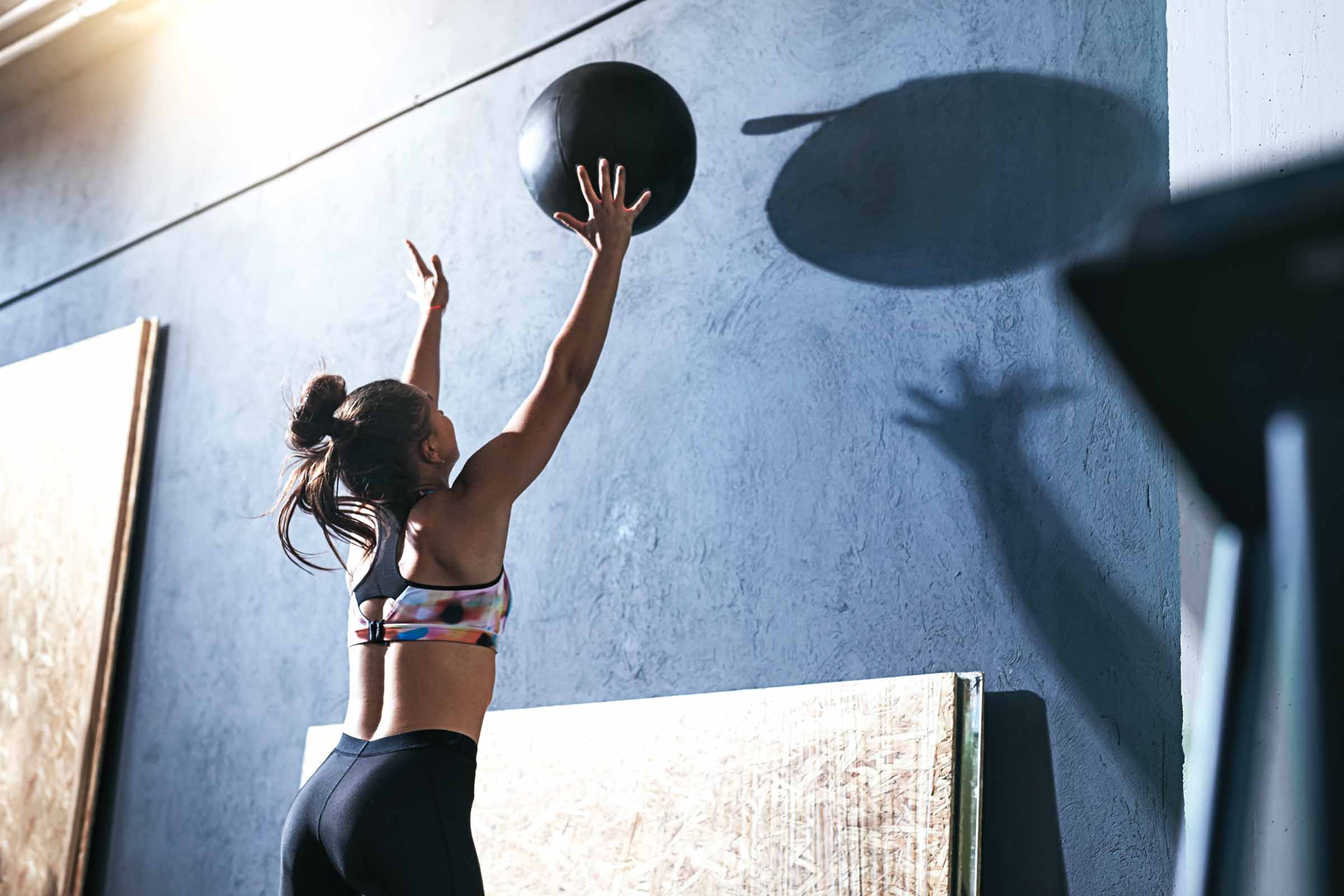5 Best Medicine Ball Exercises For Training Strength & Power

Jack McCormick has been a coach and trainer since 2009. He’s worked in a range of settings from college sports performance to tactical S&C. Here, he explains how and why you should include med balls in your training with these five effective exercises.

The Medicine Ball: A Simple Staple for Every Gym
Someone once asked me, “If money and space were no issue and you could only have three pieces of equipment in your facility, what would they be?”
What a question. There are countless expensive, high-tech options that occupy a lot of space and offer the ability to target various training and recovery adaptations.
But my response? Quite simple: a foam roller, a kettlebell, and a medicine ball.
While unassuming in both appearance and price tag, few pieces of equipment offer more versatility and bang for your buck than a medicine ball.
The ability of one piece of equipment to effectively train power, strength, and conditioning makes it an extremely high-value tool. It’s also relatively inexpensive, not very heavy, and takes up very little space.
Here are the five best medicine ball movements for super strength, ultimate power, and conditioning that gets your heart pumping with little force on your joints.
Med Ball Movements for Power Production
Power development is easily one of the most overlooked qualities in many training plans. This is likely because a lot of people make their fitness goals about improving aesthetics or getting stronger.
Most people don’t consider power development necessary for making drastic changes in body composition. It’s also a lot harder to notice quantifiable changes in this training quality (e.g., “I can now lift 50 lbs for 8 reps instead of 6,” as with a lot of strength training exercises).
All that said, power is a very important quality to train because we start to lose it past the age of 30.
Don’t worry, though – incorporating power exercises into your training program combats this natural decline, and medicine balls are an excellent tool to do this. Two of my favorite exercises are an overhead throw to a wall, and a standing rotational throw to a wall.
1. Overhead Throw
You get a lot of bang for your buck with the overhead throw to the wall. I recommend erring on the side of lighter weights for this exercise because the focus is on generating maximum speed.
For most people, something in the neighborhood of 4-6 lbs is great. This movement not only generates power, but also works in some dynamic core stability and decelerative work for the rotator cuff.
Focus on a tall posture at the start and snap your hips back to generate the movement. The next part is key: keep a stiff torso after generating the hip power so that you can transfer the force through a stable spine and out through your arms and into the ball.
Obviously your torso is going to move some, but it’s important to focus on not rounding your back. By keeping your abdominals stiff (as if you’re doing a plank), your hip power is able to transfer through a stable core effectively and into the ball.
Keep reps to no more than 8 per set. This keeps power production high and avoids fatigue. Remember, you want maximum speed, and if you fatigue then you aren’t not generating power optimally.
2. Standing Rotational Throw
Like the overhead throw, the goal of this movement is to generate power from your hips movement and not your lower back.
The exercise is initiated by driving off your back leg. This generates hip power that is transferred through a stable lumbar spine and out into the ball.
I love this exercise because it reinforces optimal mechanics for rotary power, and performing the exercise on each side of the body addresses side-to-side asymmetries. Obviously, one side likely feels more natural (given most people have a handedness and leg dominance), but it’s a good skill to recognize and develop.
Like the overhead throw, I recommend keeping reps in the 5-8 rep range per side.
Full-Body Strength Builders
Two of my favorite med ball strength training movements that add variety to training are push ups with one hand elevated on a medicine ball and a medicine ball hamstring curl.
3. Med Ball Push Up
To do a medicine ball push up, start with one hand on top of the ball. This is a lot more difficult than a standard push up because you’re going from four solid points of stability down to three, with one of them becoming unstable.
This challenges your core and shoulder stability, making it a very good early progression toward one-arm push ups. Since one hand is elevated on an unstable surface, you aren’t able to produce as much force with that arm. This allows you to bias the entire force required toward the arm on the ground.
Start with 5-6 reps per side. Remember these are significantly more challenging than regular push-ups.
4. Medicine Ball Hamstring Curl
The medicine ball hamstring curl ticks a unique box in my programming philosophy of “bent-knee hip dominant.” The single-leg Romanian deadlift is an example of a hip-dominant exercise with a nearly extended knee. Single-leg RDLs target the glutes and the hamstrings to function as hip extensors, but I like to include posterior chain work that gets your hamstrings functioning in active knee flexion and extension while your glutes provide hip extension.
Enter: the medicine ball hamstring curl.
The key to this exercise is to bridge up with your feet on the medicine ball so you’re using your glutes to extend your hips. Then, curl the ball back toward you using your hamstrings to flex your knees.
Going back and forth through knee flexion and extension while bridging up trains your glutes and hamstrings to work together in a unique way.
Your glutes are your strongest hip extensors, and your hamstrings assist with hip extension. However, in this leg curl exercise, you’re also getting your hamstrings to function eccentrically to resist knee extension as the ball goes out, and then concentrically to flex the knee as the ball comes back.
This is a challenging exercise for some people, so I recommend starting out with a standard bridge if you struggle at first. Start with 3-5 reps of a standard bridge with a 10-second hold at the top, and then progress to med ball hamstring curl for 6-10 reps.
Extra Credit: Conditioning with Wall Balls
I sometimes incorporate medicine balls during circuits at the end of workouts for conditioning. I use different medicine ball throw variations for this at times, I prefer to keep throws in the power development category.
My favorite medicine ball exercise for conditioning is the wall ball.
5. Wall Balls
What I like most about the wall ball is that it elevates your heart rate in a total-body movement while avoiding the ground-reaction forces of movements like jumping or running.
I use both bodyweight and goblet squats in conditioning circuits at times, and I like to think the wall ball sits somewhere in the middle of the spectrum of squat-based options.
The total-body nature required to propel the ball up at a spot on the wall several feet above you generates a decent cardiovascular stimulus with very little stress on the joints.
I like using something between 5-10 reps when including the wall ball as part of a metabolic conditioning circuit.
All that said, there is a variety of equipment for all types of movements, from barbells, to sandbags, to kettlebells, to any and everything in between.
But now you understand how many boxes the medicine ball can tick. Given how inexpensive, light, and space-saving they are, they are a tremendously valuable addition to any gym.
If anything, including medicine ball exercises in your current training routine is a great way to change things up and provide a new stimulus.
Disclaimer: The views and opinions expressed in this article are my own and not those of my employer. This article was written on my own personal computer and not as part of any work done for my employer.
Want Training Tips, Exercise Guides & Knowledge Bombs Sent to Your Inbox?
Sign up for the FitNerd newsletter from TrainHeroic
Related articles
3 Ways to Improve Mobility Without Stretching
Are you still trying the endless foam rolling and stretching exercises to get that deep squat position? We know how important mobility is for great, or even GOOD performance. All professional athletes have some comfortability in end ranges of motion. So, what else do...
The Ultimate Guide to Lunges: Queen of all Glute Exercises
Your glutes are the largest muscle group in your body. They’re responsible for almost everything your legs do—walking, running, jumping, squatting, lunging, and just standing upright. As far as moving through space goes, strong glutes are the bedrock of overall...
A Beginner’s Guide to Steel Mace Training
Author: Jesse Grund
Mace training will make you a better mover without it’s not confining you to a fixed space or predetermined range of motion. Second, it’s an offset load with 80 to 90 percent of the weight in the head. You’re also constantly having to resist rotation, which creates greater core engagement.

Join the community
Sign up for the latest training news and updates from TrainHeroic
For Coaches
Support
Made with love, sweat, protein isolate and hard work in Denver, CO
© 2023 TrainHeroic, Inc. All rights reserved.







